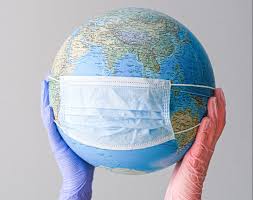A Year of COVID. . . what do we now know
 While there has been some discrepancy on the case because of cruise ship involvement elsewhere, most people will say that the first COVID-19 death in America happened on February 28, 2020, in the Seattle area. That’s just over a year ago. . . . what have we learned. . . what do we now know?
While there has been some discrepancy on the case because of cruise ship involvement elsewhere, most people will say that the first COVID-19 death in America happened on February 28, 2020, in the Seattle area. That’s just over a year ago. . . . what have we learned. . . what do we now know?
COVID-19 and the coronavirus pandemic have changed some of our daily habits. We know that.
For Angie and I, our first change of habit occurred on February 1 of last year when we boarded an airline flight home from Honolulu, Hawaii. I remember it well because for the first time in our lives we grabbed wet-wipes and sanitized our seats, arm rests, and tray tables before take-off. I don’t know about the rest of you, but that seems like a decade ago for me.
One habit that changed for us is that we now wear masks on a commercial airline carrier. One interesting note from our world is that our oldest son is a commercial pilot, but also an Aviation Business major graduate and manages an airport. He has told us an interesting fact in his world is how many people are chartering private airplanes for families going on vacation or to weddings, etc. to avoid commercial carriers. It makes me wonder on how the airplane charter business, that has now been discovered by many, will pick up post-pandemic because of a change in this habit.
Since that Hawaiian flight last year we have learned a new vocabulary and meanings such as “social distance”, “mandatory masks”, and “hybrid instruction”. We have been real careful about who we let in our home — even to the point that our two children and us celebrated Easter Sunday on our deck. . . .6-feet apart from each other.
My weekly Bible study has been cancelled since last March and Angie, who has worked as a volunteer for over 20 years in our local school system -primarily helping elementary children in the library –was not welcomed back this year. . . . simply because volunteers, in order to have less human density in the school, were not allowed.
I still serve on the board of the University of Minnesota and have been on campus only two days since last February. I’ve got really good at Zoom meetings, but it is a challenge to operate a major university with a $4 billion budget from my home office. We’ve made a lot of decisions at the University with the knowledge we had at the time. . . . .not all decisions turned out to be perfect but they were made on a “Safety first” manifestation knowing what we knew at the time.
Operating your funeral home you did the same. . . .you made the best decision knowing what you did at the time. Funeral homes have learned a lot and as I study the financial reports of the funeral home public companies it becomes apparent that funeral homes and their directors did some of what they do best. . . .use their resilience to rise to the occasion and serve their clientele in ways that were acceptable to society knowing what we knew at the time.
It was interesting for me to see the patterns of revenue per case for the public companies as we progressed through the pandemic. That number dropped like a rock out of a Boeing jet in March and April of 2020 but has risen to almost pre-pandemic levels during the 4th Quarter of 2020. That tells me that funeral directors found a way to help grieving families have some type of service that allowed them to grieve.
While that number has been comforting to me in both a helping families cope way and in a financial profitability way for funeral homes, I continue to wonder what the COVID experience for families will mean long term for our profession. Have many families learned to do without some things we expect they need for grief relief. . . . things such as public visitations, public funerals and memorial services.
Will we have a “new norm” going forward for many that will de-emphasise the rituals of death care?
I think of my new habits as a person paying respects to a death and the family of the deceased. Pre-COVID, my ritual was always to go to the funeral home in the late afternoon when a visitation was starting and pay my respects by visiting with the surviving spouse and saying hello to those relatives from out of town that I came to know growing up or over the years.
However, COVID has changed all that for me. I now check the funeral home website from time to time and the modus operandi is to put a note for the family to see on the funeral home provided deceased “Tribute Wall”. Habits are hard to change. . . . will I now go back to the in-person stop that takes an hour out of my day? I sure hope so. . . . . . the human soul needs that human touch and human emotion. . . . .not only for the deceased’s family, but for those of us who are there to help them, too. We need it. . . . .it is part of humanity.
I’ve mentioned this before. The book “Megatrends” written by John Naisbitt in the early 1980’s. Naisbitt looked into the future and talked about the trends shaping the United States. He envisioned a society where we are much more technological savvy and involved with technology.
Naisbitt also made a comment in that book that has stuck with me for forty years and encompassed how I carried out my job as a funeral director. Naisbitt opined that “The more High Tech we become, the more High Touch we will need”. We are now forty years from Naisbitt writing that and I don’t believe that it has ever been more real in our world of Zoom funerals and internet “Tribute Walls”.
There is some good news coming on the horizon. Just this week, the last of the 270 Apple stores in the United States that closed last March 13 for the COVID pandemic has re-opened. Those stores span virtually all states and the geographic reach of the United States. Texas and Mississippi governors announced the complete opening of their states. If these things are happening, can the lifting of funeral and memorial attendance rules be far behind?
Funeral directors and others in the death care profession have helped our grieving society as needed in the past year, but we now realize that our work is not over. When we can do so without fear of contagion, we have to move our communities forward by letting them know that “high touch” is needed. We need to encourage the attendance at visitations and services to make sure that humanity gets that high touch that it needs. . . . .both for the family who needs it at the time and for the rest of us.
Related: Celebrating our Spirit: Smaller gatherings challenge grieving process for funeral homes. Lima News (OH)
More news from the world of Death Care:
- Ban on Funerals. Jamaica Observer. Jamaica
- Business Spotlight: Quad Cities Cremation Center. Video Story. OurQuadCities.com (IA/IL)
- Revealed: How much more will you pay for a cremation. Isle of Wright County Press (Great Britian)
- Whitcomb-Lynch Funeral Home changes name to Apfel Wolfe Funeral Home. Gazette Extra (WI)
Enter your e-mail below t0 join the 1,920 others who receive Funeral Director Daily articles daily:





















